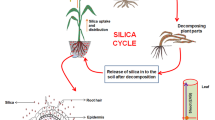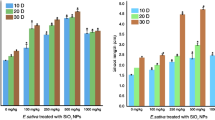Abstract
The last few decades have witnessed a dramatic progress of human civilization via industrialization, which, in turn, is associated with a surge in pollution of the environment. Heavy metals being one of the most hazardous pollutants have posed a serious threat to life sustaining ecosystem. Among the various remediation techniques, presently, the use of nanoparticles as adsorbents and chelator of heavy metal ions has emerged being practical and cost effective. Mesoporous silica nanoparticles, due to its unique structural attributes, have found application in adsorption of heavy metals in solutions. This study encompasses elucidation of the role of mesoporous silica nanoparticles MCM 41 and MCM 48 in mitigating stress caused by toxic dose of heavy metal Hg2+ (25 ppm) on growing seedlings of Vigna radiata and probiotic soil bacteria Bacillus coagulans. The results revealed that application of the nanoparticles at specific concentration can stimulate an increase in growth of plantlets, decrease in the yield reactive oxygen species like superoxide anion and hydrogen peroxide, reduction of lipid peroxidation, increase in antioxidant enzyme activity in Vigna radiata, and enhancement of growth of Bacillus coagulans as compared to that of Hg2+ alone. Moreover, it was found that MCM 41 was effective at higher dosages compared to MCM 48, which indicates the structure to function relationship.
Graphical abstract









Similar content being viewed by others
Data availability
Authors do not have permission to disclose data and materials.
References
Ambo PBN, Ethiopia EA, Serfoji P, Rajeshkumar S, Selvaraj T (2010) Management of root-knot nematode, Meloidogyne incognita on tomato cv Pusa Ruby. by using vermicompost, AM fungus, Glomus aggregatum and mycorrhiza helper bacterium Bacillus Coagulans. J Agric Sci Technol 6:37–45
Anbia M, Kargosha K, Khoshbooei S (2015) Heavy metal ions removal from aqueous media by modified magnetic mesoporous silica MCM-48. Chem Eng Res Des 93:779–788
Ansari MKA, Ahmad A, Umar S, Iqbal M (2009) Mercury-induced changes in growth variables and antioxidative enzyme activities in Indian mustard. J Plant Interact 4(2):131–136
Antochshuk V, Olkhovyk O, Jaroniec M, Park IS, Ryoo R (2003) Benzoylthiourea-modified mesoporous silica for mercury (II) removal. Langmuir 19(7):3031–3034
Batueva TD, Shcherban MG, Kondrashova NB (2019) Mesoporous silica materials and their sorption capacity for tungsten (VI) and molybdenum (VI) ions. Inorg Mater 55:1146–1150
Beauford W, Barber J, Barringer AR (1977) Uptake and distribution of mercury within higher plants. Physiol Plant 39(4):261–265
Cheng J, Sun Z, Yu Y, Li X, Li T (2019) Effects of modified carbon black nanoparticles on plant-microbe remediation of petroleum and heavy metal co-contaminated soils. Int J Phytorem 21(7):634–642
Cui H, Shi Y, Zhou J, Chu H, Cang L, Zhou D (2018) Effect of different grain sizes of hydroxyapatite on soil heavy metal bioavailability and microbial community composition. Agr Ecosyst Environ 267:165–173
Damiri F, Andra S, Kommineni N, Balu SK, Bulusu R, Boseila AA, Akamo DO, Ahmad Z, Khan FS, Rahman M, Berrada M (2022) Recent advances in adsorptive nanocomposite membranes for heavy metals ion removal from contaminated water: a comprehensive review. Materials 15(15):5392
Fagbemi OK, Sanusi AI (2016) Effectiveness of augmented consortia of Bacillus coagulans, Citrobacter koseri and Serratia ficaria in the degradation of diesel polluted soil supplemented with pig dung. Afr J Microbiol Res 10(39):1637–1644
Feng X, Fryxell GE, Wang LQ, Kim AY, Liu J, Kemner KM (1997) Functionalized monolayers on ordered mesoporous supports. Science 276(5314):923–926
Godbold DL (1991) Mercury-induced root damage in spruce seedlings. Water Air Soil Pollut 56(1):823–831
Gratão PL, Polle A, Lea PJ, Azevedo RA (2005) Making the life of heavy metal-stressed plants a little easier. Funct Plant Biol 32(6):481–494
Greathouse JA, Duncan TJ, Ilgen AG, Harvey JA, Criscenti LJ, Knight AW (2021) Effects of nanoconfinement and surface charge on iron adsorption on mesoporous silica. Environ Sci Nano 8(7):1992–2005
Hatamian M, Rezaei Nejad A, Kafi M, Souri MK, Shahbazi K (2020) Interaction of lead and cadmium on growth and leaf morphophysiological characteristics of European hackberry (Celtis australis) seedlings. Chemical and Biological Technologies in Agriculture 7:1–8
He J, Reddy GV, Liu M, Shi P (2020) A general formula for calculating surface area of the similarly shaped leaves: evidence from six Magnoliaceae species. Global Ecol Conserv 23:e01129
Idris SAM (2015) Adsorption, kinetic and thermodynamic studies for manganese extraction from aqueous medium using mesoporous silica. J Colloid Interface Sci 440:84–90
Liu AM, Hidajat K, Kawi S, Zhao DY (2000) A new class of hybrid mesoporous materials with functionalized organic monolayers for selective adsorption of heavy metal ions. Chem Commun 13:1145–1146
Mercier L, Pinnavaia TJ (1997) Access in mesoporous materials: advantages of a uniform pore structure in the design of a heavy metal ion adsorbent for environmental remediation. Adv Mater 9(6):500–503
Mercier L, Pinnavaia TJ (1998) Heavy metal ion adsorbents formed by the grafting of a thiol functionality to mesoporous silica molecular sieves: factors affecting Hg (II) uptake. Environ Sci Technol 32(18):2749–2754
Mitra S, Kumar R, Roy P, Basu S, Barik S, Goswami A (2019) Naturally occurring and synthetic mesoporous nanosilica: multimodal applications in frontier areas of science. Int J Nanosci 18(05):1850027
Mitra S, Mukherjee N, Das S, Sau A, Chakraborty S, Dwivedy S, Adak S, Arunava SG (2021) Regulatory role of nanoporous silica on dicot Cicer arietinum and monocot Sorghum bicolor. Res J Agric Sci 12:10129–21020
Mitra S, Chakraborty S, Mukherjee S, Sau A, Das S, Chakraborty B, Mitra S, Adak S, Goswami A, Hessel V (2022) A comparative study on the modulatory role of mesoporous silica nanoparticles MCM 41 and MCM 48 on growth and metabolism of dicot Vigna radiata. Plant Physiol Biochem 187:259–236
Mondal NK, Das C, Datta JK (2015) Effect of mercury on seedling growth, nodulation and ultrastructural deformation of Vigna radiata (L) Wilczek. Environ Monit Assess 187(5):1–14
Mourhly A, Kacimi M, Halim M, Arsalane S (2020) New low cost mesoporous silica (MSN) as a promising support of Ni-catalysts for high-hydrogen generation via dry reforming of methane (DRM). Int J Hydrogen Energy 45(20):11449–11459
Mukherjee N, Mitra S, Adak S, Chakraborty S, Sau A, Goswami A (2020) Evaluation of the growth response of spore forming lactic acid Bacillus-Bacillus coagulans in presence of oxide nanoparticles. Appl Nanosci 10(11):4075–4086
Mureseanu M, Reiss A, Stefanescu I, David E, Parvulescu V, Renard G, Hulea V (2008) Modified SBA-15 mesoporous silica for heavy metal ions remediation. Chemosphere 73(9):1499–1504
Nisha P, Sreedevi S (2008) Phytotoxicity of mercury on seed germination in Vigna radiata (L.) Wilczek. Biodivers Conserv, Sci Pub, pp 227–234
Noreen Z, Ashraf M, Akram NA (2010) Salt-induced regulation of some key antioxidant enzymes and physio-biochemical phenomena in five diverse cultivars of turnip (Brassica rapa L). J Agron Crop Sci 196(4):273–285
Patra M, Sharma A (2000) Mercury toxicity in plants. Bot Rev 66(3):379–422
Rabbani MM, Ahmed I, Park SJ (2016) Application of nanotechnology to remediate contaminated soils. Environmental remediation technologies for metal-contaminated soils, pp 219–229
Saiyad SA, Jhala YK, Vyas RV (2015) Comparative efficiency of five potash and phosphate solubilizing bacteria and their key enzymes useful for enhancing and improvement of soil fertility. Int J Sci Res Publ 5(2):1–6
Shaw BP (1995) Effects of mercury and cadmium on the activities of antioxidative enzymes in the seedlings of Phaseolus aureus. Biol Plant 37:587–596
Singh J, Kalamdhad AS (2011) Effects of heavy metals on soil, plants, human health and aquatic life. Int J Res Chem Environ 1(2):15–21
Singh J, Lee BK (2016) Influence of nano-TiO2 particles on the bioaccumulation of Cd in soybean plants (Glycine max): a possible mechanism for the removal of Cd from the contaminated soil. J Environ Manage 170:88–96
Tafazoli M, Hojjati SM, Biparva P, Kooch Y, Lamersdorf N (2017) Reduction of soil heavy metal bioavailability by nanoparticles and cellulosic wastes improved the biomass of tree seedlings. J Plant Nutr Soil Sci 180(6):683–693
Tutic A, Novakovic S, Lutovac M, Biocanin R, Ketin S, Omerovic N (2015) The heavy metals in agrosystems and impact on health and quality of life. Open Access Maced J Med Sci 3(2):345
Wang Y, Huang S, Kang S, Zhang C, Li X (2012) Low-cost route for synthesis of mesoporous silica materials with high silanol groups and their application for Cu (II) removal. Mater Chem Phys 132(2–3):1053–1059
World Health Organization (2021) Preventing disease through healthy environments: exposure to mercury: a major public health concern.
Web reference
Acknowledgements
We would like to express gratitude to HOD, AERU for his unending cooperation. We would also like to thank field assistant Asim Dhar.
Funding
This work was supported by University Grants Commission (UGC Fellowship), Indian Space Research Organization (Grant no. ISRO/ RES/3/827/19–20) and Indian Statistical Institute (Grant no. ISI/TAC/PROJECT1/2020–21). Sutanuka Mitra received funds from UGC, and Arunava Goswami acquired the other two funds.
Author information
Authors and Affiliations
Contributions
All authors contributed equally. Conceptualization, methodology, software, validation, formal analysis, investigation, writing (original draft), visualization, supervision, project administration and funding acquisition were done by Sutanuka Mitra. Investigation and formal analysis were performed by Sampurna Mukherjee.
Moumita Sil assisted in writing (Original Draft) and investigation. Piyali Maitra and Serene Adak helped in investigation. Arunava Goswami supervised in writing (review and editing) and acquired funding. Volker Hessel supervised in writing (review and editing) and visualization.
Corresponding author
Ethics declarations
Ethical approval
No humans or live animals were used for the study.
Consent to participate
Not applicable.
Consent for publication
Not applicable.
Competing interests
The authors declare no competing interests.
Additional information
Responsible Editor: Gangrong Shi
Publisher's note
Springer Nature remains neutral with regard to jurisdictional claims in published maps and institutional affiliations.
Rights and permissions
Springer Nature or its licensor (e.g. a society or other partner) holds exclusive rights to this article under a publishing agreement with the author(s) or other rightsholder(s); author self-archiving of the accepted manuscript version of this article is solely governed by the terms of such publishing agreement and applicable law.
About this article
Cite this article
Mitra, S., Mukherjee, S., Sil, M. et al. Role of mesoporous silica nanoparticles in combating mercury-induced stress in Vigna radiata (mung bean) and Bacillus coagulans (soil bacteria). Environ Sci Pollut Res 30, 109343–109353 (2023). https://doi.org/10.1007/s11356-023-30088-5
Received:
Accepted:
Published:
Issue Date:
DOI: https://doi.org/10.1007/s11356-023-30088-5




